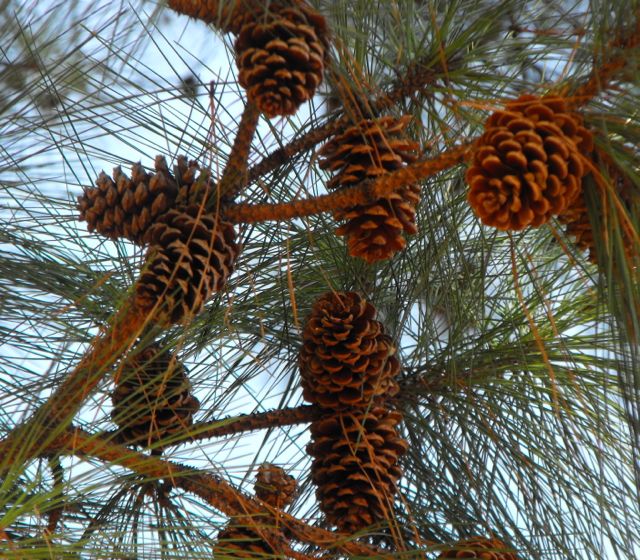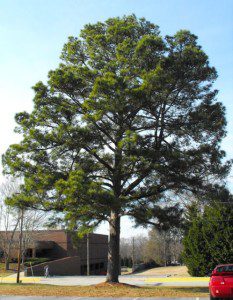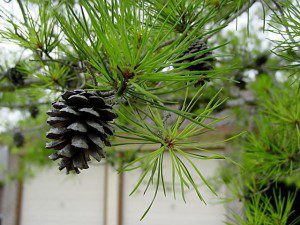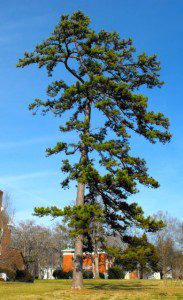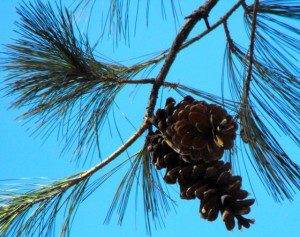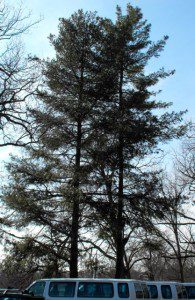Winter is a good time to develop appreciation for our pines. They are more noticeable now, as are other evergreen trees, and there are several notable and easy to recognize members of the Pine family.
One example is the Loblolly pine, botanical name Pinus taeda. These trees are the ones you see planted as “tree farms” along our roads. In the southeast, these trees are fast growing and widely cultivated for paper pulp and lumber. Loblolly pines are the second most common species of tree in the country according to the U.S. Forest Service. (Red Maple is number one!) The common name “loblolly” means “mud hole,” as these trees can grow well in moist soils. Loblolly pine needles are 4 to 9 inches long, mostly in groups of three. Male (pollen) cones are 1.5 inches long and drop off right after releasing pollen in the Spring. Pine pollen is not usually allergenic. Mature female (seed) cones are 4 to 6 inches long and may remain on branches 1 to 4 years.
Another pine species of our region is the Shortleaf pine, botanical name Pinus echinata, which were especially important lumber trees during South Carolina’s early history. Shortleaf pines of large size and maturity are unusual to find now because many were lost years ago due to a fungus called Little-leaf Disease, scientific name Phytophthora cinnamomi. There were many these of old pines on the John de la Howe forest land of McCormick County. We’re lucky to have the ones that are left. These pines are also growing now as volunteers along roads and in natural areas. Short leaf pines have needles 3 to 4.5 inches long, grouped in twos, and their small prickly cones tend to stay attached to branches from year to year.
A third notable species of pine is the Eastern White Pine, botanical name Pinus strobus. The tallest trees of Eastern North America are White Pines, some reaching 180 feet. Also called the Northern White pine, they prefer a cool humid climate, so you see more of them in the piedmont and mountains.Trees have branches in regular whorled arrangement around the trunk. Slender, gray-green needles measure 2.5 to 5 inches long, are in groups of five. Female (seed) cones are slender, about 7 inches long, and tipped with white resin. White pines are grown for lumber, Christmas trees and landscaping. Upstate South Carolina does not have an ideal climate for White Pine, yet folks living at lower altitudes often plant them.
Winter is also a good time to do all we can to avoid colds and other ailments. Believe it or not, pine trees have a long history of food and medicinal use practiced by Native Americans. Eastern White Pines were an important food and vitamin source that made it possible for tribes of the Adirondacks (name meaning “tree eaters”) to live healthily through harsh winters of the Northeast. Early colonists eagerly claimed lands already inhabited by Mohawk, Oeinida, Seneca, and Iroquois who were regarded as savages. The newcomers harvested many many White Pines for lumber, firewood, and especially ship masts. After winters in which countless colonists died from vitamin C deficiency called scurvy, compassionate native tribes taught them their long established practice of regularly drinking White Pine needle tea, rich in Vitamin C and A. That was one of many practical lessons those uncultured “savages” taught land usurping folks many of us call ancestors!
Pine Needle Tea Recipe from the Farmer’s Almanac
“Chop and bruise a good handful of young green pine needles. Remove any brown ends and chop into half-inch pieces. Place needs in a glass, ceramic, or stainless teapot. Pour two cups of boiling water over the needles, cover the pot, and allow to steep for a few minutes. The tea will turn a pale green with a light, piney smell. Most of the needles with sink to the bottom and you can pour the tea in to a mug. It’s delicious. Some folks add a squirt of lemon or mix with another tea, too.” ‘And honey is a good medicinal sweetener to add because it soothes a scratchy sore throat.
http://www.almanac.com/blog/natural-health-home-tips/pine-needle-tea
Further reading: http://www.practicalprimitive.com/skillofthemonth/pineneedletea.html
by Jan Haldeman, February 2016

